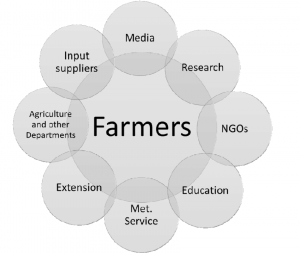2021 International Youth Day & The Development Of Nigerian Agricultural Innovation System (NAIS)
Reflecting on this year’s international youth day theme – “Transforming Food Systems: Youth Innovation for Human and Planetary Health”, I got thinking about the political economy of Nigeria’s agricultural sector. It made me ask – why is Nigeria, despite being endowed with agricultural land, favorable climatic conditions, and a huge supply of human resources, faced with a grand challenge of food insufficiency and remaining a net importer of food? Also, I began to consider some of the challenges that need to be addressed to enable the agricultural sector to thrive and for the country to meet SDG2 which aims at zero hunger for all.

To start off with, when considering the historical-political landscape of Nigeria’s agriculture sector one would argue that Nigeria has been locked in, from the colonial era to basic farming for export and consumption resulting in little development in food processing and other value-chain activities. Also, despite the involvement of different international organizations over the years in funding programs, there has not been continuity from ever-changing government policies and programs from colonial days to date, which seems to have stunted the agricultural sector.
The second factor to consider is the fact that the economic assessment of this sector reveals the fall, over the years, in the contribution of agriculture to the GDP and the fact that Nigeria continues to be a net importer of food. Nigeria has a trade deficit of agricultural goods with other countries, according to a PWC 2019 report. its imports accounted for 73.82%, while exports accounted for 26.18% in 2018. Nigeria’s economy continues to be dominated by oil and budget allocation is below the African Union (AU) agreed 10%. Additionally, agriculture receives less than 4% of banks’ total lending, although the CBN pledged in 2020 to increase the lending to 10% within four years.
The fifth factor to consider is the environmental issues. The environmental analysis reveals that Nigeria has mostly favorable climatic conditions to produce a variety of crops. It has an abundance of land and a well-drained water system that aids farming. However, there are areas of soil erosion caused by climate change and pollutions due to extensive oil exploration and crop damage by pests.
The sixth factor and final factor is the legal landscape. It highlights the archaic land tenure system that prevents the acquisition of new land by farmers. It also shows that the Local Government Council, entrusted by the Constitution to take care of farmers’ needs, must step up their role in creating value in the agriculture ecosystem.
Having conducted a high-level analysis of the political, economic, social, technological, environmental, and legal factors affecting the agriculture terrain in Nigeria, we should now consider ways forward to enable the transformation of food systems. According to Fagerberg, & Srholec (2008) for any form of development to take place a country needs to develop capabilities in one or more of the following areas:
- Development of the “innovation system”
- Quality of “governance”
- Character of the “political system”
- Degree of “openness” to trade and foreign direct investment
Whilst all four areas are critical, the thrust of the policy recommendations for this paper is anchored on the development of a Nigerian Agriculture Innovation System (NAIS) that focuses on SHFs. This will enable Nigeria to attain food sufficiency and achieve SDG2, especially in a post-Covid-19 world.
It is therefore recommended that government collaborates with the private sector and young people to co-create innovative solutions rather than launching top-down programs as were done in the past. There is a role to be played, along the agriculture value chain, by different sectors/actors such as local equipment manufacturing companies, financial institutions, education institutions, transportation companies, ICT/technology companies, processing industries as well as government and international agencies.
Also, the active involvement of the youth will contribute to resolving the youth unemployment challenge in Nigeria. The youth should be incentivized and funded to come up with innovative solutions to solve problems in the agriculture system and the skilled and educated young people should be encouraged to produce innovative techniques, farming equipment, and solutions to improve productivity. To ensure sustainability, the government should take a stake in the funded initiatives, in collaboration with the private sector, to share the investments’ risks and rewards
Another area to be considered in the employment of innovative procurement and local content policies that directs government-owned institutions like schools and hospitals, to purchase agricultural produces from SHFs. This will help empower farmers, combat rural poverty, and improve nutrition for all.
Finally, CBN should ensure that it expedites the attainment of the 10% of the annual budget spend on agriculture and the funds should be used for R&D and capital projects to improve infrastructure across the agriculture value chain. The funds should also be made available to SHFs to fund expansion and mechanization programs.
In conclusion, these recommendations should be considered to enable the creation of the Nigerian Agriculture Innovation System to unlock the potential of SHF’s and solve the challenge of food insufficiency. The expected outcome is that Nigeria will combat poverty, sustainably provide food for its growing population, align with the 2021 international youth day theme of achieving youth innovation for human and planetary health, and significantly meet SDG2 by 2030.
Author




